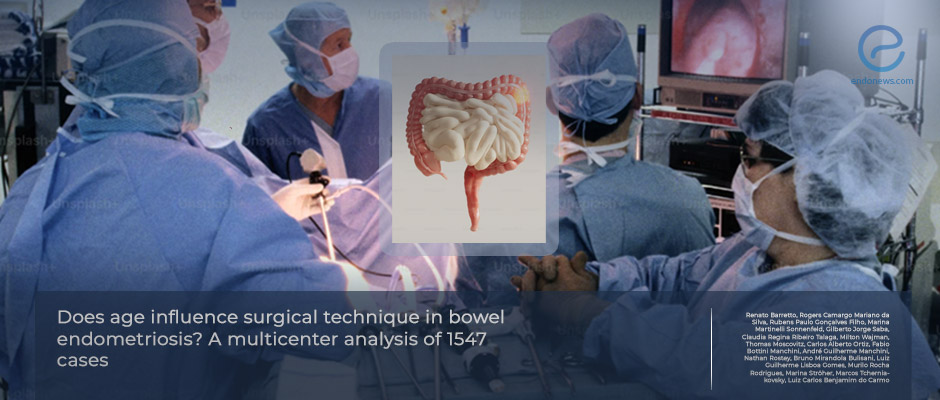Does Age Matter in Choosing Bowel Endometriosis Technique?
Nov 27, 2025
Chronological age does not guide technique selection in bowel endometriosis, but it affects the route of specimen extraction.
Key Points
Highlights:
- Age did not influence the choice between shaving, discoid, or segmental bowel resection.
- Severe complications were uncommon and depended on surgical complexity, not age.
- Surgical planning was guided by anatomy, not chronological age.
Importance:
- Age should not be used as a determinant for surgical complexity in bowel endometriosis.
- Anatomy-based, not age-based, decision-making is necessary in high-complexity rectosigmoid procedures.
What's Done Here?
- This is a multicenter retrospective analysis of 1,547 bowel endometriosis surgeries.
- The authors compared surgical techniques and extraction routes between women <35 and ≥35 years.
- The study also evaluated postoperative complications using Clavien–Dindo classification.
Key Results:
- There was no association between age and conservative vs. radical bowel resection.
- Severe complications occurred in 1.9% and were linked to surgical complexity, but not age.
- Younger women had higher odds of Pfannenstiel extraction.
- Transvaginal natural orifice specimen extraction was significantly more frequent in women ≥35 years.
Strengths and Limitations:
- Being a large cohort across multiple referral centers, standardized multidisciplinary teams which minimized operator variability are the strengths of the study.
- Retrospective design with potential selection bias, absence of systematic data on uterine preservation, functional outcomes, or sexual function, recurrence and long-term outcomes are the limitations.
From the Editor-in-Chief – EndoNews
"This large multicenter cohort provides a timely and clarifying message for the surgical management of bowel endometriosis: chronological age does not determine surgical complexity—anatomy does.
In a field where assumptions about fertility, hormonal status, and surgical tolerance can unconsciously shape decision-making, the work by Barretto et al. is particularly important. By evaluating more than fifteen hundred operations performed in expert centers, the authors offer compelling evidence that the choice between shaving, discoid resection, or segmental bowel resection should be based on the depth and extent of infiltration, not on the patient’s age.
The study also reinforces a second key point: safety is achievable across the age spectrum when surgery is performed within standardized multidisciplinary teams. Severe complications were rare and strongly correlated with the inherent complexity of the procedure rather than with the age of the patient. This finding aligns with the emerging consensus that optimal outcomes in deep infiltrating endometriosis require technical expertise, structured protocols, and mature collaboration between gynecologic and colorectal surgeons.
The only age-related difference—specimen extraction route—reflects a practical anatomic reality rather than a shift in surgical philosophy. Younger women, who more commonly preserve the uterus, are less likely to be candidates for opportunistic transvaginal extraction. The increased use of transvaginal natural orifice specimen extraction in older patients is therefore a marker of accessibility, not an indicator of surgical aggressiveness. This distinction is essential, particularly as interest grows in natural-orifice techniques and their potential to reduce pain, wound complications, and recovery time.
Perhaps the most significant contribution of this study is that it dismantles a pervasive clinical assumption. Age, long considered a proxy for reproductive goals or surgical risk, did not independently predict technique selection or complications. For clinicians, this reinforces the principle that bowel endometriosis surgery must remain lesion-driven and function-driven, not demographically driven. For patients, it provides reassurance that minimally invasive surgery—when appropriately indicated—can be performed safely regardless of age.
As surgical technologies evolve, and as robotic platforms and natural orifice specimen extraction techniques become more widely adopted, studies of this scale are invaluable. They remind us that while innovation continues, the fundamentals remain: precise preoperative assessment, anatomical understanding, and expert surgical execution are the true determinants of outcomes in bowel endometriosis."
Lay Summary
Bowel endometriosis often requires complex minimally invasive surgery, and surgeons commonly choose between shaving, discoid resection, or segmental bowel resection based on how deeply the disease infiltrates the rectum or sigmoid. It has long been assumed that younger women might be offered more conservative procedures, while older women might undergo more extensive surgery. However, this assumption had never been tested in a large, real-world population.
In this multicenter study published in the Journal of Robotic Surgery, Renato Barretto and colleagues analyzed 1,547 surgeries performed for bowel endometriosis across several high-volume referral centers in Brazil. The team examined whether a patient’s age influences the type of bowel surgery performed, the route of specimen extraction, or the risk of postoperative complications.
The results showed that age did not affect whether a patient underwent shaving, discoid resection, or segmental bowel resection. Severe complications were uncommon and were linked to the complexity of the procedure itself—not to the patient’s age. The only age-related difference was in how the bowel specimen was removed: younger women more often required abdominal extraction (Pfannenstiel incision), while older women more frequently underwent transvaginal natural orifice specimen extraction, likely because uterine preservation in younger patients limits vaginal access.
Overall, this large study demonstrates that surgical planning in bowel endometriosis is guided by anatomical disease characteristics rather than chronological age, reinforcing that both younger and older patients can safely undergo minimally invasive surgery when managed in specialized centers.
